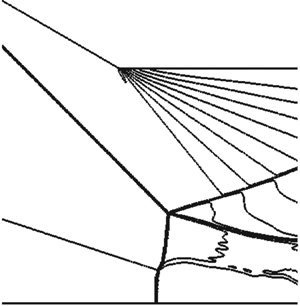Article contents
Mach reflection promoted by an upstream shock wave
Published online by Cambridge University Press: 02 October 2020
Abstract

Mach reflection subjected to the influence of an upstream shock wave from the same side is studied here. This situation occurs when two incident shock waves induced by a double wedge reflect at the same point of the reflecting surface and when the downstream incident shock wave is stronger than the upstream one. A shock polar analysis is used to show that this configuration produces an inverted Mach stem and a type IV shock interference between the Mach stem and the upstream shock wave. This shock interference produces a jet that divides the flow stream downstream of the Mach stem into two ducts with different sonic throats, thus complicating the mechanism by which the Mach stem size is determined. A transition analysis shows that the Mach reflection of the downstream shock wave is promoted by the upstream one. Computational fluid dynamics is used to assess the flow pattern anticipated by shock polar analysis and demonstrates how the heights of Mach stem and jet depend on the inflow Mach number and wedge turning angle.
JFM classification
- Type
- JFM Papers
- Information
- Copyright
- © The Author(s), 2020. Published by Cambridge University Press
References
REFERENCES
- 5
- Cited by



